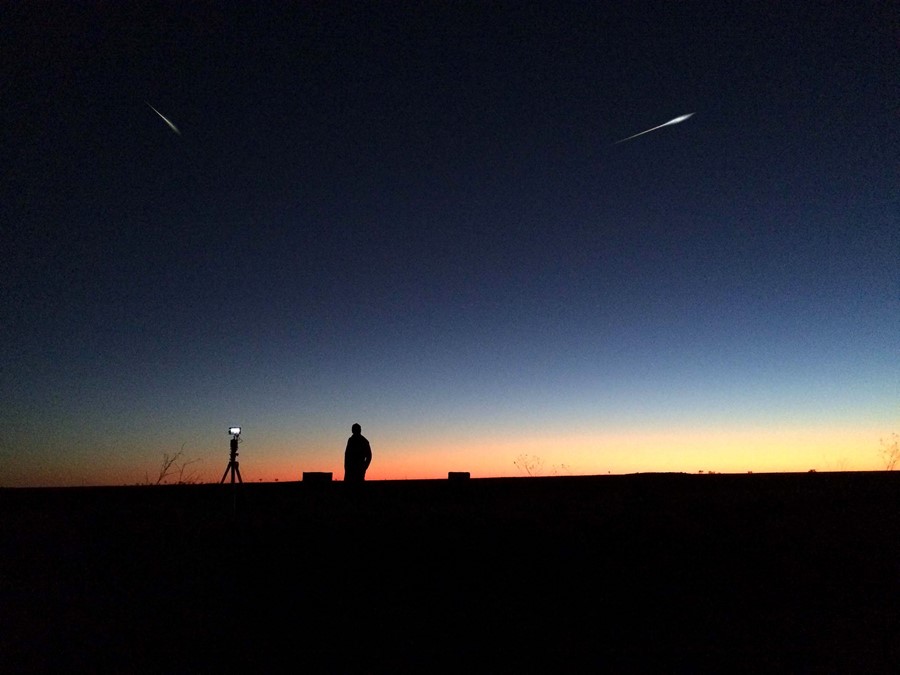Acclaimed directors Werner Herzog and Clive Oppenheimer discuss Fireball: Visitors from Darker Worlds, which examines the science and human stories of meteorites
In his new film, Fireball: Visitors from Darker Worlds, Werner Herzog explores the raw beauty and cosmic power of meteorites. The science documentary, co-directed by Cambridge University geographer and seismologist Clive Oppenheimer, traces the fascinating ways in which fragments of rocks from outer space have made renowned impressions far beyond the edges of any individual crater.
On 7 November 1492, the first recorded meteorite crashed into earth in the form of a fiery space rock shooting through the sky. It punched a hole three feet deep into the soil of a wheat field near French town Ensisheim, with a young boy as its only witness, as history recalls. At the time, the remarkable force of the meteorite impressed Austrian military commander, King Maximilian, who came to the town to battle the French a week after its arrival. He labelled it “a sign of divine favor” – Herzog and Oppenheimer’s Fireball helps us understand why.
“Somebody asked me ‘what’s the interest in this, they’re just lifeless rocks these meteorites?’ But the thing is they’re anything but lifeless,” says Oppenheimer. “Some of them are stuffed full of organic molecules and might be the building blocks of life. And of course, from time to time they barrel into our planet and reset the biological clock as they did 65 million years ago with the asteroid’s impact. So I think what fascinates us about them is how interwoven the nature of these stones or shooting stars impact the human nature that surrounds them.”
While the examination of meteorites is a scientific matter, there is also a spiritual element to it. In the documentary we’re shown how they exert their energy upon the earth, not only through multiple interviews with many eclectic people who study the larger-than-life forces but through breathtaking footage of fire light meteorites dashing across the sky and lunging towards earth.
“There are so many films that have been made for TV documentaries on meteorites, as well as Hollywood movies like Deep Impact, and others that look at the doomsday scenario, but I think what Werner and I achieve is a gripping new form of science documentary which is about the human stories not just the science,” Oppenheimer explains. “It asks what is the significance of this crater for the aboriginal communities? What are the oral traditions that they’ve had about it for thousands of years? Why is there what is most likely a meteorite set in the centre of the Great Mosque of Mecca and why is this one of the holiest realms of Islam? Supposedly the stone was brought to Ibrahim by the angel Gabriel and it was given to set in the Kaaba.”
In the film, we’re shown shaky footage of the Black Stone, a sacred rock in the city of Mecca that Muslims circle around during Hajj, an annual Islamic pilgrimage that is a mandatory religious duty for Muslims to carry out at least once in their lifetime. Scientists have never been allowed to study the Black Stone but it is believed by researchers to be a meteorite. “These are things that I don’t think everyone is aware of,” adds Herzog. “I don’t think many are aware that people have found sugars in meteorites or that you can pick them up and they smell like the inside of a vacuum cleaner. That smell is four and a half million years old. It’s how the universe smelt 4,500 million years ago.”
There’s a lot to digest in the hour and 37 minutes long journey narrated by Herzog’s famous voice-over. Herzog and Oppenheimer, who previously worked together on Into the Inferno in 2016, delve into the different impact craters around the world. From the Polo Plato in Antarctica, a vast expanse of blue ice with only a handful of people scattered out looking for meteorites, to beside the sea on Meer Island in Torres Strait between Queensland and New Guinea, where we’re shown locals performing a meteorites dance. As Oppenheimer explains, “The Meer islanders believe that the souls of the departed climb up a coconut palm and launch across the night sky, so when they see a shooting star it indicates that someone has died or will die soon and this is enacted with fire torches by night.”
For Herzog, it is the different forms and sizes that fascinate him the most. “I praise micro meteorites when they’re microscopically small, it’s incredible,” he says. “But then in large they are the most beautiful sculptures. I mean the film holds its breath and it stops as it shows one after the other, they’re so beautiful.”
In Fireball, meteorites are more than flaming rocks from outer space. They write history and birth traditions and that, Herzog suggests, is why they’re worshipped. The film, which is now streaming on Apple TV, is full of contrast – visually, narratively and cinematically – yet there are interconnecting themes throughout. “It’s very easy as a storyteller to immediately know if something is big,” says Herzog. “This movie is big.”
Fireball: Visitors from Darker Worlds is now streaming on Apple TV.
